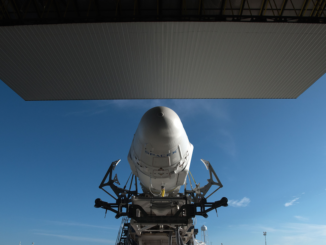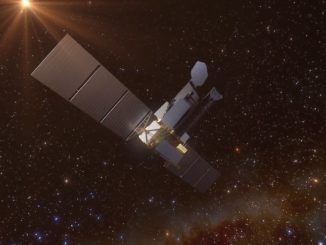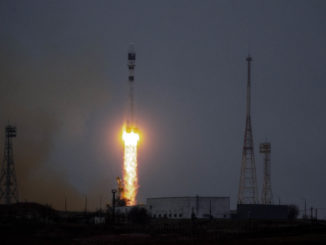STORY WRITTEN FOR CBS NEWS & USED WITH PERMISSION

On Aug. 17, gravity waves rippled through the solar system, slightly squeezing and stretching the space Earth occupies, the result of a catastrophic collision of two compact-but-massive neutron stars, producing a so-called “kilonova” explosion that seeded the local environment with a flood of heavy elements ranging from gold and platinum to uranium and beyond, scientists said Monday.
The two city-size neutron stars, one with 1.6 times the mass of the sun and the other with about 1.1 times the mass of Earth’s star, were formed in supernova explosions about two billion years after the big bang in a galaxy 130 million light years from Earth.
Circling each other in a decaying orbit, the neutron stars finally crashed together at nearly the speed of light, radiating gravitational waves and a torrent of electromagnetic radiation that reached Earth at roughly the same moment 130 million years after the fact.
It was the first time the source of a gravitational wave event could be linked to a visible counterpart, allowing scientists to study the aftermath of the collision across the entire electromagnetic spectrum, from high-energy gamma radiation to X-rays, visible light, infrared and radio.
“What this means to me is equivalent to the transition from looking at a black-and-white picture of a volcano to sitting in a 3D IMAX movie that shows the explosion of Mt. Vesuvius,” Laura Cadonati, a Georgia Tech researcher and LIGO spokeswoman, told reporters at a National Science Foundation news conference.
“The combined information of gravitational waves and light is bigger than the sum of its parts,” she said. “From the combined information we’re learning new things about physics, about the universe, about the elements we’re made of.”
An astronomical gold mine of sorts. Literally.
Theorists have long speculated that neutron star mergers could generate the enormous energies needed to synthesize elements heavier than iron. Supernova explosions also create heavy elements, but supernovas alone cannot explain the observed abundances of gold, platinum, uranium and other heavy elements.
Analysis of light from the Aug. 17 kilonova event indicates the neutron star collision in a galaxy known as NGC 4883 did, in fact, seed the local environment with a flood of heavy elements.
The combined observations “revealed details that we’ve never seen before in any astronomical event, the direct fingerprints of the heaviest elements in the periodic table — gold, platinum, and other elements,” said Edo Berger, a Harvard University astronomer who led a team of observers.
“From the properties of the visible and infrared light, we conclude the total mass of heavy elements produced in this one single event is 16,000 times the mass of the Earth,” he said. “Of this material, we estimate that about 10 times the mass of the Earth is in gold and platinum alone. So imagine this as you gaze at your jewelry or invest in gold futures.”
The gravitational waves were detected at 8:41 a.m. on Aug. 17 by the Laser Interferometer Gravitational-Wave Observatory, or LIGO, which in 2015 made the first observation of two black holes merging — a discovery that won the 2017 Nobel Prize.
This time around, the gravity waves were followed in seconds by detection of high-energy gamma rays by the European Space Agency’s Fermi Space Telescope. It was the first direct confirmation that gravitational radiation travels at the speed of light.

Within the next few hours, more than 70 observatories around the world, along with seven space-based instruments, were on the look out for an optical counterpart.
Astronomers with the Carnegie Institution for Science and the University of California at Santa Cruz were the first to pinpoint the collision using the 1-meter Swope Telescope at the Cerro Las Campanas observatory in Chile. They spotted a brilliant blue “star” in the galaxy NGC 4883 in the constellation Hydra.
Along with visible light, astronomers quickly detected infrared radiation, ultraviolet emissions, X-rays and radio waves as the object faded from blue to red, all expected signals from a cataclysmic event like the merger of two neutron stars.
“We finally now know what happens when an unstoppable force meets and immovable object,” said Andy Howell, a University of California-Santa Barbara astronomer. “And the answer is a kilonova.”
Tony Piro, leader of the Carnegie team, said in a statement “the ability to study the same event with both gravitational waves and light is a real revolution in astronomy. We can now study the universe with two completely different probes, which teach us things we could never know with only one or the other.”
LIGO has detected multiple black hole mergers, but black holes are, by definition, black, they do not generate light and cannot be directly seen. Astronomers predicted neutron star collisions would be visible if astronomers knew where to look.
The combination of LIGO’s gravity wave detection and Fermi’s detection of gamma rays narrowed the search and paved the way for the Swope telescope and others to find the cosmic needle in an equally cosmic haystack.
“We saw a bright blue source of light in a nearby galaxy, the first time the glowing debris from a neutron star merger had ever been observed,” Carnegie astronomer Josh Simon said in a statement. “It was definitely a thrilling moment.”
Simon and Carnegie astronomer Ben Shappee then used spectrographs mounted on the observatory’s huge 6.5-meter Magellan telescopes to analyze the light.
“As we followed the glow of the explosion over the next few weeks, it showed some key characteristics of the radioactive decay of these heavy elements,” said Maria Drout, a Carnegie researcher who helped guide the search. “This strongly suggests that these elements were synthesized following the merger, solving a 70-year-old mystery.”
One yet-to-be-answered question: what sort of body was left after the two neutron stars merged?
“There are some signs, some observations that have been made that suggest it should be a black hole,” said David Shoemaker, LIGO’s lead spokesman. “But in terms of its mass and all of the gravitational wave data, it could be either one of the heaviest neutron stars that’s ever been seen or one of the very lightest black holes that’s ever been seen.”
Eleonora Torja at NASA’s Goddard Space Flight Center believes the X-ray data shows a black hole is the most likely result.
“Very likely, the collision of two neutron stars resulted in a new black hole,” she said. “And this black hole ejected a high-speed jet of energy and matter. This jet was carrying the same amount of energy that our sun radiates over millions of years, and it was expanding at close to the speed of light.”
Neutron stars represent one of three possible outcomes when stars grow old, exhaust their nuclear fuel and either fade away or explode.
Stars like the sun remain stable, in a state of hydrostatic equilibrium, by balancing the outward pressure generated by nuclear fusion in the core with the inward pull of gravity. When a star runs out of nuclear fuel, fusion in the core stops, gravity takes over, the core collapses and the star’s outer layers are blown away into space.
For stars like the sun — and more than 90 percent of the stars in the Milky Way — core collapse is halted by a quantum effect known as electron degeneracy pressure, produced when electrons are squeezed as closely together as allowed in normal matter. The result is a white dwarf, a slowly cooling stellar remnant with up to 1.44 times the sun’s mass packed into a body the size of a small planet.
For larger stars, electron degeneracy is not enough to halt the core’s collapse when it runs out of fuel. Instead, gravity squeezes the core to the point where electrons merge with protons to form a neutron star, a bizarre city-size body just a few miles across with a mass of two to three times that of the sun.
“Neutron stars are the hardest things in the universe, harder than a cue ball, harder than diamond, and we really wanted to see what would happen if you smashed two of them together at near the speed of light,” said Howell.
“Neutron stars are like a giant atomic nucleus, only one 10 miles in diameter and composed entirely of neutrons. So this is like a cosmic scale atom smasher at energies far beyond what humans will ever be capable of building.”
For collapsing stars with even more massive cores, gravity overcomes even the neutron degeneracy pressure that otherwise would create a neutron star. The doomed sun becomes a black hole with many times the mass of the sun concentrated in what amounts to an invisible gravitational sinkhole.
Gravitational wave astronomy offers a powerful new way to study such high-energy events.
Einstein predicted the existence of gravitational waves in 1916 in his general theory of relativity. The equations indicated that massive bodies under acceleration, like two merging black holes, neutron stars or the collapsing cores of huge stars in the death throes of supernova explosions, would radiate gravitational energy in the form of waves distorting the fabric of spacetime.
The LIGO observatory features two stations, one in Washington and the other in Louisiana, that each feature a pair of 2.5-mile-long vacuum tubes arranged in an L shape in which precisely tuned laser beams flash back and forth between multiple mirrors. A gravitational wave stretches space in one direction and compress it in a perpendicular direction.
The effects on local space are infinitesimal, making detection a high-technology challenge and a feat Einstein could never have imagined. The LIGO equipment is sensitive enough to measure changes in the distance traveled by the laser beams to less than the width of a proton.
On Sept. 14, 2015, LIGO recorded gravitational radiation for the first time. Analyzing the data, scientists realized they had the tell-tale signature of two black holes merging. The discovery was announced the following February.



